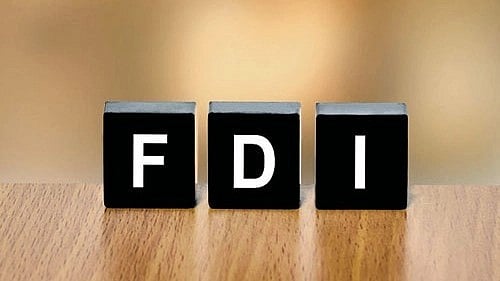
Foreign Direct Investment (FDI).
Credit: PTI File Photo
Foreign Direct Investment (FDI) — the investment from a foreign investor, company, or government into a domestic business — in India is downbeat, set to make 2023-2024 the third continuous year of decline. Foreign portfolio investment (FPI) — foreigners’ purchase of equity through stock exchanges and debt — on the contrary, is massively up. FDI contributes to capital formation, which leads to GDP growth, while FPI does not, as it is only a change of equity from one hand to another.
At a time when the stock markets are touching ‘all-time highs’, it’s worthwhile to ask: what is foreign investments’ contribution to India’s capital formation? Why is FDI declining? Why is there a frenzy in buying stocks, but not in committing FDI?
FDI share in capital formation is small
Advance GDP numbers for 2023-2024, in current prices, estimated the gross fixed capital formation (GFCF), statisticians’ term for capital formation, at Rs 88.31 trillion ($1,064 billion); 29.8 per cent of the Rs 296.58 trillion GDP estimate for FY2024.
Capital formation in India, after declining to a low of 27.25 per cent in 2020-2021 has been rising steadily. In 2021-2022, it was 28.91 per cent (Rs 67.86 trillion or $920 billion of a Rs 234.71 trillion GDP) and in 2022-2023, it was 29.2 per cent (Rs 79.43 trillion or $1,005 billion of a Rs 272.41 trillion GDP).
Most of the capital investment in India is funded by domestic savers, primarily households. Foreigners’ share in capital formation is quite small.
In 2021-2022, FDI inflows were $56.23 billion and, in 2022-2023 it was $42.01 billion. FDI, thus, contributed only 6.11 per cent of capital formation in 2021-2022 and 4.18 per cent in 2022-2023. It is turning out to be worse in 2023-2024. In the first six months of FY2024, FDI inflows are estimated at $20.48 billion; and is unlikely to cross $35 billion for the full year. FDI flows are likely to end up contributing less than 3.5 per cent of capital formation.
All capital inflows don’t contribute to capital formation
Gross capital account inflows comprise, besides FDI, portfolio investment, external commercial borrowings (ECBs), external assistance from multilaterals, NRI deposits, among others. As capital flows in opposite direction as well like direct investment by Indian companies abroad, net capital account flows are smaller.
In 2022-2023, gross capital account flows were $72.26 trillion, including NRI deposits worth $20.98 billion. FPI and ECBs were negative at -$4.80 billion and -$3.80 billion respectively. The net capital account flows were $58.94 billion. FDI made up 58.14 per cent of gross capital flows and 71.28 per cent of net capital account flows.
A good part of the ECBs also contributes to debt capital formation. The ECBs were negative $3.80 billion in 2022-2023. FDI and ECBs together, at $38.21 billion, were 52.88 per cent of gross capital account flows, and contributed only 5.53 per cent of gross fixed capital formation in 2022-2023.
In 2023-2024, the ECBs flow is positive. Therefore, FDI and ECBs together will make a higher contribution to capital formation; though it will be in miniscule single digits.
Why is FDI on down?
FDI, like any other capital, seeks the best value addition and profit-making opportunity.
In the first decade of this millennium, it was manufacturing and infrastructure as global and Indian demand for steel, cement, aluminium, and other industrial goods soared on the back of big investment, primarily in China. India was investing heavily in infrastructure — roads, power, and telecom — as well.
The disappearance of Chinese demand and severe profitability issues in infrastructure after the global financial crisis made industry and infrastructure investment in India quite unattractive. Subsequently, FDI also stopped flowing.
Services, especially in BFSI (banking, financial services and insurance), data processing, and e-commerce, riding on the wave of startups and GCCs (global capability centres), attracted big FDI after the Covid-19 outbreak in 2020.
Lack of profitability, greed, and governance issues in Indian startups have spoiled the FDI participation in the startups. Over-reach of policy in data control and social media is also acting as a discouragement to FDI. The wave in GCCs seems to be maturing.
All these factors together perhaps explain why FDI inflows are on a downward path.
FPI inflows are fair-weather friends
Foreigners’ purchase of Indian stocks and debt (FPI) have violently gyrated in tune with their perception of whether Indian markets would go up or down. In 2013-2014, FPI inflows were $5.03 billion. After the Narendra Modi government took over and stock markets were expected to rise massively, the FPI inflows skyrocketed to $42.19 billion. When the economy was seen as weakening in 2018-2019, the last year of first Modi government, FPIs became net sellers of $405 million.
In 2020-2021, FPIs saw big profit opportunity and invested $38.73 billion. When the markets turned bearish, the FPIs net-sold stocks (including debt) of $14.07 billion in 2021-2022 and $4.83 billion in 2022-2023.
This year (FY2024) is seen as the year of big profit opportunity. No wonder FPIs have invested nearly $30 billion in its first nine months.
Focus on services digitally produced
India needs to focus on services digitally produced and delivered for domestic and global consumption. India does not have great technological prowess, but has fabulous talent to build and deliver services on the new tech.
A policy which attracts foreign technology backed by FDI to use and harness Indian talent will bring big dollops of FDI dollars. It is not wise to seek confirmation of the Indian economy’s well-doing looking at FPI flows.
Subhash Chandra Garg is former Finance & Economic Affairs Secretary, and author of ‘The Ten Trillion Dream’ and ‘We Also Make Policy’.
(Disclaimer: The views expressed above are the author's own. They do not necessarily reflect the views of DH).